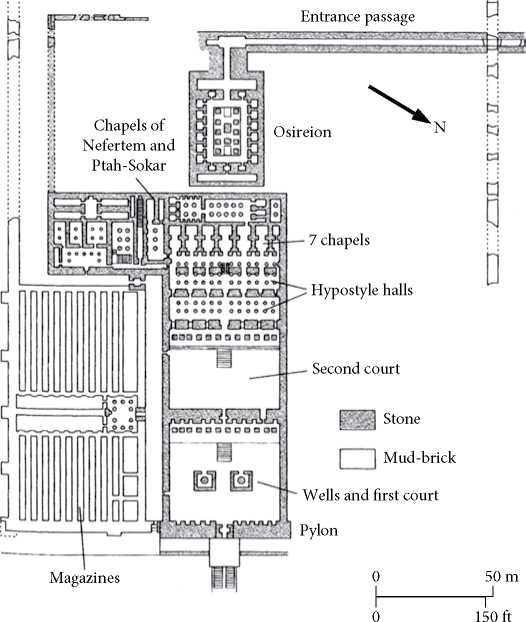Destruction of Akhenaten’s monuments continued in the 19th Dynasty, and restoration of the old cults included the construction of new monuments to Egypt’s gods. At Abydos, the important cult center for Osiris, the god who judged all in the afterlife, Sety I built a large temple to the south of the earlier Kom el-Sultan temple to Khentiamentiu/Osiris (in which the earliest artifacts are from Early Dynastic times) (Figure 8.11). Sety’s temple, which was also worked on by Rameses II, was cleared in the 19th century by Auguste Mariette. To the north of his father’s temple, Rameses also built for himself a comparable but smaller temple decorated on the outside with scenes of his Battle at Qadesh.

Figure 8.11 Abydos, plan of the Temple of Sety I/Rameses II. Source: Drawn by Philip Winton. Richard H. Wilkinson, The Complete Temples of Ancient Egypt. London and New York: Thames & Hudson. 2000, p. 147.
Sety I’s Abydos temple originally had two forecourts, with a large pylon fronting the first one, next to which was a large block of long narrow storerooms. These structures are in ruins today and the entrance to the present temple begins at the second portico. Behind this portico are two transverse hypostyle halls, with seven bark chapels in the rear of the temple dedicated to the deified Sety I, Ptah, Ra-Horakhty, osiris, Isis, and Horus, with Amen-Ra’s chapel in the center. Behind these chapels is the Osiris complex, with three chapels at each end and two columned halls. The reliefs in the osiris complex are about the life and death cycle of the god, and, according to Rosalie David, rituals were held there only once a year, relating to the annual festival of Osiris. The ground plan of the temple forms an unusual “L,” with an addition to the south of the seven chapels including chapels of two important Memphite gods, Nefertem and Ptah-Sokar. In this area of the temple is Sety’s famous king list, which excludes the “illegitimate” rulers of the Amarna Period and its aftermath.
A second structure was also built by Sety I (and partly decorated by King Merenptah), behind (west of) and aligned to his L-shaped temple. This is the so-called Osireion, a symbolic tomb of Osiris. Massive red granite piers were built on top of a platform, around which was a trench for water. The passage leading to it is decorated with mortuary compositions, as in a royal tomb, and the Osireion seems to have been a variation of the plan of a royal tomb, but with some unique features.




 World History
World History









